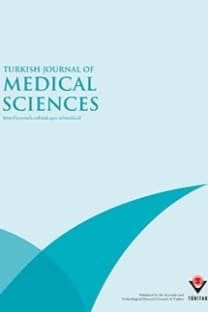Evaluating the Persian versions of two psoriatic arthritis screening questionnaires early arthritis for psoriatic patients questionnaire (EARP) and psoriasis epidemiology screening tool (PEST) in Iranian psoriatic patients
Evaluating the Persian versions of two psoriatic arthritis screening questionnaires early arthritis for psoriatic patients questionnaire (EARP) and psoriasis epidemiology screening tool (PEST) in Iranian psoriatic patients
___
- 1. Alinaghi F, Calov M, Kristensen LE, Gladman DD, Coates LC et al. Prevalence of psoriatic arthritis in patients with psoriasis: A systematic review and meta-analysis of observational and clinical studies. Journal of the American Academy of Dermatology 2019; 80: 251-265.e219. doi:10.1016/j. jaad.2018.06.027
- 2. Haroon M, Gallagher P, FitzGerald O. Diagnostic delay of more than 6 months contributes to poor radiographic and functional outcome in psoriatic arthritis. Annals of the Rheumatic Diseases 2015; 74: 1045-1050. doi:10.1136/ annrheumdis-2013-204858
- 3. Gladman DD, Antoni C, Mease P, Clegg DO, Nash P. Psoriatic arthritis: epidemiology, clinical features, course, and outcome. Annals of the Rheumatic Diseases 2005; 64 Suppl 2:ii14-17. doi:10.1136/ard.2004.032482
- 4. Taylor W, Gladman D, Helliwell P, Marchesoni A, Mease P et al. Classification criteria for psoriatic arthritis: development of new criteria from a large international study. Arthritis and Rheumatism 2006; 54: 2665-2673. doi:10.1002/art.21972
- 5. Chiowchanwisawakit P, Wattanamongkolsil L, Srinonprasert V, Petcharat C, Siriwanarangsun P et al. Developing the Thai Siriraj psoriatic arthritis screening tool and validating the Thai Psoriasis epidemiology screening tool and the early arthritis for psoriatic patients questionnaire. Rheumatology International 2016; 36: 1459-1468. doi:10.1007/s00296-016-3513-4
- 6. Ibrahim GH, Buch MH, Lawson C, Waxman R, Helliwell PS. Evaluation of an existing screening tool for psoriatic arthritis in people with psoriasis and the development of a new instrument: the psoriasis epidemiology screening tool (PEST) questionnaire. Clinical and Experimental Rheumatology 2009; 27: 469-474.
- 7. Tinazzi I, Adami S, Zanolin EM, Caimmi C, Confente S et al. The early psoriatic arthritis screening questionnaire: a simple and fast method for the identification of arthritis in patients with psoriasis. Rheumatology (Oxford, England) 2012; 51: 2058-2063. doi:10.1093/rheumatology/kes187
- 8. Haroon M, Kirby B, FitzGerald O. High prevalence of psoriatic arthritis in patients with severe psoriasis with suboptimal performance of screening questionnaires. Annals of the Rheumatic Diseases 2013; 72: 736-740. doi:10.1136/ annrheumdis-2012-201706
- 9. Baek HJ, Yoo CD, Shin KC, Lee YJ, Kang SW et al. Spondylitis is the most common pattern of psoriatic arthritis in Korea. Rheumatology International 2000; 19: 89-94. doi:10.1007/ s002960050109
- 10. Beaton DE, Bombardier C, Guillemin F, Ferraz MB. Guidelines for the process of cross-cultural adaptation of self-report measures. Spine 2000; 25:3186-3191. doi:10.1097/00007632- 200012150-00014
- 11. Mishra S, Kancharla H, Dogra S, Sharma A. Comparison of four validated psoriatic arthritis screening tools in diagnosing psoriatic arthritis in patients with psoriasis (COMPAQ Study). The British Journal of Dermatology 2017; 176:765-770. doi:10.1111/bjd.14929
- 12. Coates LC, Aslam T, Al Balushi F, Burden AD, Burden-Teh E et al. Comparison of three screening tools to detect psoriatic arthritis in patients with psoriasis (CONTEST study). The British Journal of Dermatology 2013; 168: 802-807. doi:10.1111/bjd.12190
- ISSN: 1300-0144
- Yayın Aralığı: 6
- Yayıncı: TÜBİTAK
Ali ALAGÖZ, Nilgün Yılmaz DEMİRCİ, Semih AYDEMİR, Hilal SAZAK, Fatma ULUS, Mehtap TUNÇ
Projecting the course of COVID-19 in Turkey: A probabilistic modeling approach
Seher Nur SÜLKÜ, Aybar C. ACAR, Hüseyin Cahit BURDUROĞLU, Yeşim AYDIN SON, Levent AKIN, Serhat ÜNAL, Ahmet Görkem ER
İlker EYÜBOĞLU, Serdar ASLAN, İsmet Miraç ÇAKIR, Ahmet SARI
Imaging modalities used in diagnosis and follow-up of patients with Takayasu’s arteritis
Levent KILIÇ, Abdulsamet ERDEN, Ayşe Bahar KELEŞOĞLU DİNÇER, Umut KALYONCU, Sedat KİRAZ, Ömer KARADAĞ, Tuncay HAZIROLAN
MUC1 and MUC5AC implication in Tunisian colorectal cancer patients
Dhouha BACHA, Donia OUNISSI, Marwa WESLATI, Rahma BOUGHRIBA, Meriam HAZGUI, Saadia BOURAOUI
Pınar BULUTAY, Pınar FIRAT, Handan ZEREN, Suat ERUS, Serhan TANJU, Şükrü DİLEGE
Muhterem DUYU, Selin YILDIZ, Zeynep KARAKAYA
Uğur ÇELİK, Zekayi KUTLUBAY, Cem MAT, Ayşegül SEVİM KEÇİCİ
Aygül TANTİK PAK, Alpay ALKAN, Yıldızhan ŞENGÜL, Hafize OTCU
